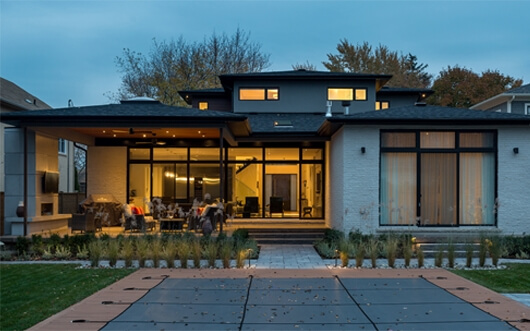How to Choose the Best Window to Install


Choosing the right kind of window to replace or install in your home
Windows have the power to give life to your home. They can create a nearly seamless connection with the outside world, both letting light in, and letting insiders to see outside.
Over the past 50 years, windows construction technology has improved so much, that a new standard for living is achieved with simply having new modern windows. New windows have insulative properties, that both keep your home warm in the winter and cool in the summer. These elements are not available on most old windows. So, how do you know which ones to replace?
What insulates a home?
Being insulated from harsh weather elements requires several factors in a house:
- Design of the house (passive solar, light-exposing layout, direction of eaves, many other factors)
- Insulation and thickness of walls
- Quality and construction of the windows
While the layout and design of a house, along with its wall construction are difficult to impossible to change without major construction, windows can easily be replaced. Besides, windows typically cover 15-20% of the wall space1 in an average home, and, if they are older, can lead to 30% of a home’s heating and cooling costs2 . Window replacement remains the most effective way to improve the insulation and efficiency of an already existing home.

UV Damage8
In addition to insulation and weathertightness factors, replacing windows with new ones has a side benefit. The coatings found on many new windows help reduce UV and other harmful light rays, that often cause fading to the interior of the home, including its furniture and window coverings. New windows with Low-E coatings can reduce harmful rays and heat loss by 40-70%.10
So let’s focus on windows. What elements of windows should I be looking for before I replace them?
How do I know which ones to choose for long-lasting energy efficiency.
Several elements to consider
- Efficiency features
- Tempered vs. standard
- Efficiency ratings and labels
- Style & function
- Installation
There are many features that make today’s windows more energy efficient. Below, we will go through each of these elements.
Number of Panes
A pane, is a layer of glass that forms the core of the window. This process of adding panes can sometimes be called glazing. Yet, single-paned windows are horribly inefficient. If you have any, these should take your top priority to replace. Older homes often have these. This makes for an easy decision.
The question remains, what about double pane vs. triple pane? Double pane windows are the most common and popular window pane construction in the market. They provide a large jump in window energy efficiency for the little added cost. While triple pane windows may add slightly more energy efficiency (about 10-20%) the cost may not be worth the jump. Triple pane may be a nice luxury, and if you can afford it, by all means, go ahead with them. Colder locations, such as northern Canada, will benefit the most from triple pane windows.
But double-pane does most of the job, for much less cost than triple pane. Also, if you already have double-pane windows, that are new, it certainly will not be worth your expense to replace to triple pane. But older windows, and single-pane, are all good candidates for replacement.
Tempered glass
Also, with the glass itself, you will want to find out if tempered glass is required for your building codes. Often, windows that are low to the ground, may be required to be tempered. Tempered glass is a process, after a window is manufactured, that treats the window, essentially “curing” it. Using heat and chemicals, it strengthens the glass. The result is glass that would shatter into soft round pebbles, rather than fractured glass splinters, if the window was ever broken. It’s a safety feature, and comes at added cost, but may be required for certain window locations.
Insulative frames
The frames of windows themselves can provide an insulation factor. Most new vinyl windows have some of this insulation value in them. If you have old wood framed windows, chances are, there are small cracks that you may not even notice. Replacing these will give you a benefit of insulation. Also, aluminum frames will conduct more energy loss than vinyl window frames.
Low conductive spacers
The gaps between the panes (whether double or triple pane) are held together by spacers, that are designed to keep a precise amount of space between each glass pane. In lower quality windows, these spacers can be energy suckers themselves, by conducting temperature loss between the gaps. Consider higher-quality windows, which have use low conductive spacers.
Low-E coatings

Low Emissivity (branded as Low-E in the window industry) is a rating for window films. New, high-quality windows, receive a microscopic layer of metallic film. These layers help block harmful lightrays from the sun, along with blocking heat from leaving the interior of your home. In one way, think of it as “sunscreen for your house”. 6
Typically, the more layers, the more cost, but also higher efficiency. The result is a window that lets most visible light in, but insulates the interior of the home from the exterior of the home. You will notice ultra-Low-E windows often have a slight tan or purple tint, and are typically standard in most custom and luxury homes. . . . for good reason. They create a solid comfortable feel inside the home, and have the highest energy efficiency on the market. Also, do not confuse Low-E with tinting. Tinting is material added into the class material, and honestly, does little compared with Low-E windows, which are coatings. Heavily tinted windows can become very hot in the sun, and yet provide little insulative value.
The more coatings, the better, especially for north-facing windows5
Air leakage
Are there cracks in your glass? Are there wide seams in the frames? Have the seals cracked? All of these lead to loss of energy. Often, a sign of this is condensation within the panes. This is a type of window that is functioning basically like an old single-paned window. Replace them.
Gas filled or not?
Argon, Krypton and Xenon. Argon being the most popular, is a gas that is filled in the gap between the panes. It provides an additional thermal barrier, thereby adding to the efficiency of a window. Stated plainly, it reduces the heat transfer between the interior of your home and outdoors. Combine this with Low-E coatings and solid insulative vinyl frames, and you have a window that is ideal for making a warm comfortable home in Toronto. Krypton gas is similar, but is used typically in triple pane windows. You may have heard of Xenon. Although it may have the highest thermal value, it is not common and currently not worth the cost.
How to understand the ratings and labels: 8 , 9
The NFRC label provides four metrics for consumers. Especially common in use throughout the USA and Canada:
- U-Factor: Keeping the heat inside. This is most important in Toronto in the winter months. The lower the number, the better the window.
- Visible Transmittance: How much visible natural light is let in? The higher the number, the better the window. During the darker months, you want a window that lets as much visible light as possible. It reduces the need for too much electric interior lighting, leading to a side benefit of additional energy savings.
- Solar Heat Gain Coefficient: During the summer how well does this window reduce unwanted heat gain? The lower the number, the better quality the window, leading to lower cooling costs.
- Air Leakage: How many places does this window let air pass from the inside to the outside? look for lower number ranges. These are better insulated windows.
When it comes to EnergyStar window labels, 3 , 4, they are similar. It may have an additional metric called Energy Rating (ER) which gives you a combined rating of several factors involving the metrics above.
When you see EnergyStar labels, especially EnergyStar Core, you know you are purchasing a high insulative window.


Styles of windows

Now that we have concluded that double pane, vinly windows, with preferably Argon gas, and Low-E coating are the ideal windows to consider purchasing, let’s consider style.
Style can include many factores, including the shape, frame construction, and functions (like opening, sliding, etc.)
For example, bathrooms typically have smaller, and blurred (also called privacy) windows. Some kitchens have garden windows (window boxes that petrude outside of the house). Also there are internal grids, which tend to give a more country or ranch look to the window. If you want to go modern, consider no grids or mid-frames. Simply pure glass will do for modern.
What style matches your home? What style matches your neighborhood? What functions do you need for each room?
Delco Windows and Doors, a window installer in Toront, Ontario Canada mentions: there are so many styles of windows to choose from. Perhaps too many. What you should start with is what is important to you. Function vs. fashion.
They go on to list these styles and types of windows: Tilt & Turn, Casement, Awning, Single Slider, Double Slider, Specialty, Aluminum, Hybrid Wood, Single Hung, Double Hung, Bay/Bow, and even many more variations and customizations.
If you are in a historic district, such as Old Town or Yorkville areas of Toronto, where keeping a classic look is important, you may consider specialty or hybrid wood frame windows. There are even double-pane windows that more closely mimic the looks of old single-pane windows. If you are in an ultra-modern custom home, large casement windows, with triple pane, and multiple Low-E coatings would be a good choice.
Better yet, come to a showroom of a local window installer, like Delco, or others, and touch and feel the product. Imagine it in your home, rather than simply seeing pictures.

Installation
Lastly, You may have found the best energy-efficient window, and the right style, but now you need to install it right. If the window is not installed correctly, all of the energy saving factors we just talked about go “out the window”. A simple thing as a 1/8cm difference in measurement can make the difference between a fully functioning window, versus a drafty window. Making your home solid, and insulated, while stylish, requires work by installers who do it all the time. Your best bet is to go with window installation companies. They’ve seen it all, and usually get it right the first time, while warrantying their work.
Overall, looking for energy efficient windows that serve you desired function, to replace old windows. This will allow you to enjoy your home to the fullest, while improving its value.
--------------------------------------
Robert James is a writer for home improvement and energy efficiency topics in the fine homecrafting industry throughout Canada and the USA.
----------------------------------------
Resources and References
- https://www.e-education.psu.edu/egee102/node/2017
- https://www.energy.gov/energysaver/design/windows-doors-and-skylights/update-or-replace-windows
- https://www.nrcan.gc.ca/energy-efficiency/energy-star-canada/about-energy-star-canada/participant-resources/technical-specifications/windows-doors-and-skylights-energy-star-canada-technical-specification/20950
- https://www.nrcan.gc.ca/energy-efficiency/energy-efficiency-products/product-information/windows-doors-skylights/sample-labels-windows-doors-and-skylights/13958
- https://books.google.com/books?id=kW3KksuNn0IC&pg=PA9&lpg=PA9&dq=krypton+window+air+canada&source=bl&ots=m1okFXLB-D&sig=ACfU3U2x_7up2gS3AN2TERL0iZmuDjspyQ&hl=en&sa=X&ved=2ahUKEwj36t_C6pzpAhXjGDQIHezzBOgQ6AEwC3oECAwQAQ#v=onepage&q=krypton%20window%20air%20canada&f=false
- https://www.realtor.com/advice/home-improvement/energy-efficient-windows-how-much-will-you-save/
- https://weatherspark.com/y/19863/Average-Weather-in-Toronto-Canada-Year-Round
- https://www.energystar.gov/products/building_products/residential_windows_doors_and_skylights/benefits
- https://www.nfrc.org/#tabs-nfrclabels|0
- http://americanenergyinnovation.org/wp-content/uploads/2013/03/Case-Low-e-Windows.pdf











